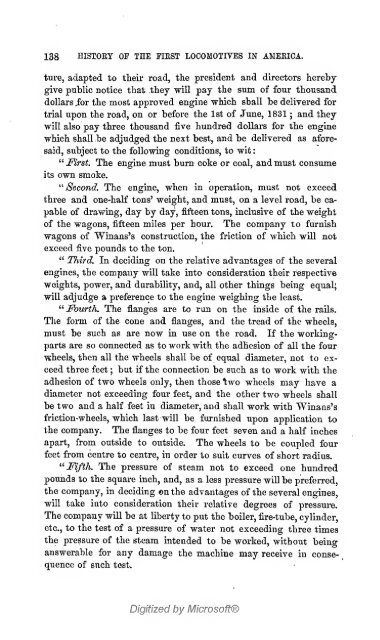The history of the first locomotives in America. From original ...
The history of the first locomotives in America. From original ...
The history of the first locomotives in America. From original ...
You also want an ePaper? Increase the reach of your titles
YUMPU automatically turns print PDFs into web optimized ePapers that Google loves.
138<br />
HISTORY OF THE FIKST LOCOMOTIVES IN AMERICA.<br />
ture, adapted to <strong>the</strong>ir road, <strong>the</strong> president and directors hereby<br />
give public notice that <strong>the</strong>y mil pay <strong>the</strong> sum <strong>of</strong> four thousand<br />
dollars for <strong>the</strong> most approved eng<strong>in</strong>e which shall be delivered for<br />
trial upon <strong>the</strong> road, on or before <strong>the</strong> 1st <strong>of</strong> June, 1831 ; and <strong>the</strong>y<br />
"will also pay three thousand five hundred dollars for <strong>the</strong> eng<strong>in</strong>e<br />
which shall be adjudged <strong>the</strong> next best, and be delivered as afore-<br />
said, subject to <strong>the</strong> follow<strong>in</strong>g conditions, to wit<br />
" First. <strong>The</strong> eng<strong>in</strong>e must burn coke or coal, and must consume<br />
its own smoke.<br />
^'Second. <strong>The</strong> eng<strong>in</strong>e, when <strong>in</strong> operation, must not exceed<br />
three and one-half tons' weight, and must, on a level road, be ca-<br />
pable <strong>of</strong> draw<strong>in</strong>g, day by day, fifteen tons, <strong>in</strong>clusive <strong>of</strong> <strong>the</strong> weight<br />
<strong>of</strong> <strong>the</strong> wagons, fifteen miles per hour. <strong>The</strong> company to furnish<br />
wagons <strong>of</strong> W<strong>in</strong>ans's construction, <strong>the</strong> friction <strong>of</strong> which will not<br />
exceed five pounds to <strong>the</strong> ton.<br />
" Third. In decid<strong>in</strong>g on <strong>the</strong> relative advantages <strong>of</strong> <strong>the</strong> several<br />
eng<strong>in</strong>es, <strong>the</strong> company will take <strong>in</strong>to consideration <strong>the</strong>ir respective<br />
weights, power, and durability, and, all o<strong>the</strong>r th<strong>in</strong>gs be<strong>in</strong>g equal;<br />
will adjudge a preference to <strong>the</strong> eng<strong>in</strong>e weigh<strong>in</strong>g <strong>the</strong> least.<br />
" Fourth. <strong>The</strong> flanges are to run on <strong>the</strong> <strong>in</strong>side <strong>of</strong> <strong>the</strong> rails.<br />
<strong>The</strong> form <strong>of</strong> <strong>the</strong> cone and flanges, and <strong>the</strong> tread <strong>of</strong> <strong>the</strong> wheels,<br />
must be such as are now <strong>in</strong> use on <strong>the</strong> road. K <strong>the</strong> work<strong>in</strong>g-<br />
parts are so connected as to work with <strong>the</strong> adhesion <strong>of</strong> all <strong>the</strong> four<br />
wheels, <strong>the</strong>n all <strong>the</strong> wheels shall be <strong>of</strong> equal diameter, not to ex-<br />
ceed three feet ; but if <strong>the</strong> connection be such as to work with <strong>the</strong><br />
adhesion <strong>of</strong> two wheels only, <strong>the</strong>n those 1;wo wheels may have a<br />
diameter not exceed<strong>in</strong>g four feet, and <strong>the</strong> o<strong>the</strong>r two wheels shall<br />
be two and a half feet <strong>in</strong> diameter, and shall work with W<strong>in</strong>ans's<br />
friction-wheels, which last will be furnished upon application to<br />
<strong>the</strong> company. <strong>The</strong> flanges to be four feet seven and a half <strong>in</strong>ches<br />
apart, from outside to outside. <strong>The</strong> wheels to be coupled four<br />
feet from centre to centre, <strong>in</strong> order to suit curves <strong>of</strong> short radius.<br />
"^ Fifth. <strong>The</strong> pressure <strong>of</strong> steam not to exceed one hundred<br />
pounds to <strong>the</strong> square <strong>in</strong>ch, and, as a less pressure will be prefei-red,<br />
<strong>the</strong> company, <strong>in</strong> decid<strong>in</strong>g «n <strong>the</strong> advantages <strong>of</strong> <strong>the</strong> several eng<strong>in</strong>es,<br />
will take <strong>in</strong>to consideration <strong>the</strong>ir relative degrees <strong>of</strong> pressure.<br />
<strong>The</strong> company will be at liberty to put <strong>the</strong> boiler, fire-tube, cyl<strong>in</strong>der,<br />
etc., to <strong>the</strong> test <strong>of</strong> a pressure <strong>of</strong> water not exceed<strong>in</strong>g three times<br />
<strong>the</strong> pressure <strong>of</strong> <strong>the</strong> steam <strong>in</strong>tended to be worked, without be<strong>in</strong>g<br />
answerable for any damage <strong>the</strong> mach<strong>in</strong>e may receive <strong>in</strong> conse-<br />
quence <strong>of</strong> such test.<br />
Digitized by Micros<strong>of</strong>t®<br />
:
















